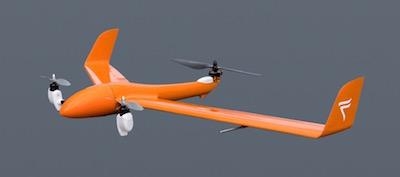Sun, Sep 16, 2018
FlightWave Edge Deployed In Cutting Edge Study Aboard the Schmidt Ocean Institute’s R/V Falkor
The FlightWave Edge UAS was part of a high-tech flotilla of underwater vehicles (AUVs), autonomous surface vessels (ASVs), and unmanned aerial vehicles (UAVs) used on the research ship R/V Falkor in its study of an area of the Pacific Ocean approximately 1,000 miles west of Southern California in an area called the Subtropical Front.

The mission: Establish a new method for observing dynamic ocean systems and processes with autonomous vehicles that maintain constant communication between themselves and a remote control center on the Falkor.
The ecological mysteries of the Subtropical Front are extremely important for scientists to unravel and understand, and also offer a highly valuable opportunity for researchers to experiment with the simultaneous management of multiple autonomous vehicles.
Principal Investigator João Tasso de Figueiredo Borges de Sousa of the Laboratório de Sistemas e Tecnologias Subaquáticas (LSTS) from Porto University and his team are leading the effort, along with researchers from the Interdisciplinary Centre of Marine and Environmental Research (CIIMAR), a leading research and advanced training institution of the University of Porto in Portugal; Technical University of Cartagena in Spain; Norwegian University of Science and Technology in Norway; and U.S. researchers from Harvard, University of Rhode Island, and Lamond-Doherty Observatory.
The Edge worked as part of a system of autonomous marine vehicles to map out ocean fronts. Researchers will use it to try out three types of sensors: a thermal camera to measure sea surface temperature, a multispectral camera to detect plankton, and a special sensor made by NASA that measures a gas called DMS emitted by plankton.
“Operating from a ship out in the middle of nowhere enables us to demonstrate the Edge’s versatility and airworthiness,” said FlightWave co-founder and CTO Trent Lukaczyk, Ph.D. — who is part of the team at sea. “And there’s only one good place to land: back on the ship. The Edge’s VTOL and payload swapping are important capabilities out here. And networking into a system of autonomous assets via the Falkor’s network and supercomputer puts this demo on a whole new level.”
(Source: FlightWave news release. Image from FlightWave website)
More News
Takeoff Roll The process whereby an aircraft is aligned with the runway centerline and the aircraft is moving with the intent to take off. For helicopters, this pertains to the act>[...]
“We’re proud of the hard work that went into receiving this validation, and it will be a welcome relief to our customers in the European Union. We couldn’t be mor>[...]
"Aircraft Spruce is pleased to announce the acquisition of the parts distribution operations of Wag-Aero. Wag-Aero was founded in the 1960’s by Dick and Bobbie Wagner in the >[...]
IDENT Feature The special feature in the Air Traffic Control Radar Beacon System (ATCRBS) equipment. It is used to immediately distinguish one displayed beacon target from other be>[...]
Aero Linx: Pararescue Air Force Pararescuemen, also known as PJs, are the only DoD elite combat forces specifically organized, trained, equipped, and postured to conduct full spect>[...]
 ANN's Daily Aero-Term (05.10.24): Takeoff Roll
ANN's Daily Aero-Term (05.10.24): Takeoff Roll Aero-News: Quote of the Day (05.10.24)
Aero-News: Quote of the Day (05.10.24) Aero-News: Quote of the Day (05.11.24)
Aero-News: Quote of the Day (05.11.24) ANN's Daily Aero-Term (05.11.24): IDENT Feature
ANN's Daily Aero-Term (05.11.24): IDENT Feature ANN's Daily Aero-Linx (05.11.24)
ANN's Daily Aero-Linx (05.11.24)



